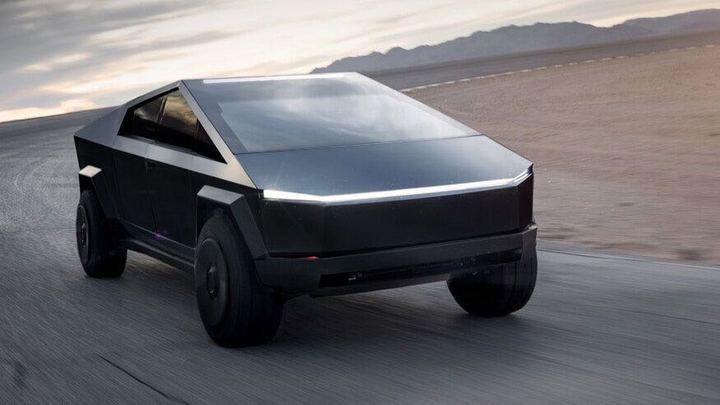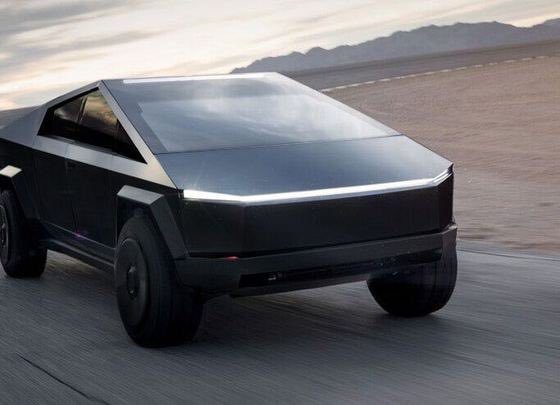

News
Elon Musk hints at smaller Tesla Cybertruck version down the road
Following the unveiling of Tesla’s Cybertruck last week, CEO Elon Musk has hinted that a smaller version of the futuristic pickup may be coming in the future. This statement from Musk came after some potential owners expressed they would be interested in a more compact version of the recently-unveiled vehicle that would be more suitable for smaller driveways and residences.
Tesla unveiled the Cybertruck on November 21. The all-electric truck from the company based out of Silicon Valley caught the eye of many people due to its unique and unorthodox shape. One Twitter follower of Musk’s requested a smaller truck down the road, as he facetiously expressed the vehicle may block his whole street. Musk replied, saying that it “probably makes sense to build a smaller Cybertruck too.”
The size of the Cybertruck is a big talking point for those who are interested in the vehicle. Its futuristic and unusually modern shape is a design that has not been used in the past by any other car manufacturer. However, not everyone who wants or needs to own a truck for either work or leisure can house this gigantic pickup.
Other manufacturers have had success varying the sizes of their trucks by releasing multiple models of the same body style. Ford, for example, has done this with its F-Series that has gained the reputation as the most popular line of pickup trucks in the U.S. in 2019, with the F-150 being recognized as the most popular truck in the country, according to J.D. Power. In terms of dimensions, the Cybertruck is similar to the F-150 and Dodge Ram 1500.
- Tesla Cybertruck: 231.5 inches long, 79.8 inches wide, 75 inches tall, 6.5-foot bed
- 2020 Ford F-150 XL: 209 inches long, 80 inches wide, 75 inches tall, 5.5-foot bed
- 2020 Dodge Ram 1500: 229 inches long, 82 inches wide, 77 inches tall, 5.6-foot bed

Tesla’s Cybertruck will give owners more storage capacity than any other pickup on the market right now thanks to its bed that is nearly a foot longer than the other two vehicles. The Ford F-150 XL has 62.5 cubic feet of storage, and while this is the company’s smallest version of the truck, it packs 62% of the storage capacity compared to the 100 cubic feet offered by Tesla’s Cybertruck. The 2020 Dodge Ram 1500 offers 61.5 cubic feet, just one foot less than the F-150 but still only a fraction of Tesla’s new “Bladerunner-Esque” pickup.
Tesla may find it beneficial down the road to try and create a smaller variation of the Cybertruck. The truck, while available in different variants as far as the number of engines, is only available in one size. While more cargo space is definitely a plus, there are certainly plenty of reasons why it could be the reason someone does not buy the vehicle. Some people simply do not have the room for a large truck, especially if they live in a small house or community where there is not enough room for the vehicle. The Twitter user who reached out to Musk recognized that the truck would be a great vehicle to own, but it may not be the most logical thing to buy considering he does not have space for it.
Elon Musk has proven to us in the past that he is a man of the people. He listens to the requests of potential Tesla owners and uses them to improve the vehicles Tesla manufactures. While the Cybertruck does not begin production until late 2021, there is plenty of time for Musk and Tesla’s team of designers to come up with a modified design that would appeal to those who do not have the need for the massive Cybertruck.

News
Tesla starts showing how FSD will change lives in Europe
Local officials tested the system on narrow country roads and were impressed by FSD’s smooth, human-like driving, with some calling the service a game-changer for everyday life in areas that are far from urban centers.

Tesla has launched Europe’s first public shuttle service using Full Self-Driving (Supervised) in the rural Eifelkreis Bitburg-Prüm region of Germany, demonstrating how the technology can restore independence and mobility for people who struggle with limited transport options.
Local officials tested the system on narrow country roads and were impressed by FSD’s smooth, human-like driving, with some calling the service a game-changer for everyday life in areas that are far from urban centers.
Officials see real impact on rural residents
Arzfeld Mayor Johannes Kuhl and District Administrator Andreas Kruppert personally tested the Tesla shuttle service. This allowed them to see just how well FSD navigated winding lanes and rural roads confidently. Kruppert said, “Autonomous driving sounds like science fiction to many, but we simply see here that it works totally well in rural regions too.” Kuhl, for his part, also noted that FSD “feels like a very experienced driver.”
The pilot complements the area’s “Citizen Bus” program, which provides on-demand rides for elderly residents who can no longer drive themselves. Tesla Europe shared a video of a demonstration of the service, highlighting how FSD gives people their freedom back, even in places where public transport is not as prevalent.
What the Ministry for Economic Affairs and Transport says
Rhineland-Palatinate’s Minister Daniela Schmitt supported the project, praising the collaboration that made this “first of its kind in Europe” possible. As per the ministry, the rural rollout for the service shows FSD’s potential beyond major cities, and it delivers tangible benefits like grocery runs, doctor visits, and social connections for isolated residents.
“Reliable and flexible mobility is especially vital in rural areas. With the launch of a shuttle service using self-driving vehicles (FSD supervised) by Tesla in the Eifelkreis Bitburg-Prüm, an innovative pilot project is now getting underway that complements local community bus services. It is the first project of its kind in Europe.
“The result is a real gain for rural mobility: greater accessibility, more flexibility and tangible benefits for everyday life. A strong signal for innovation, cooperation and future-oriented mobility beyond urban centers,” the ministry wrote in a LinkedIn post.
News
Tesla China quietly posts Robotaxi-related job listing
Tesla China is currently seeking a Low Voltage Electrical Engineer to work on circuit board design for the company’s autonomous vehicles.

Tesla has posted a new job listing in Shanghai explicitly tied to its Robotaxi program, fueling speculation that the company is preparing to launch its dedicated autonomous ride-hailing service in China.
As noted in the listing, Tesla China is currently seeking a Low Voltage Electrical Engineer to work on circuit board design for the company’s autonomous vehicles.
Robotaxi-specific role
The listing, which was shared on social media platform X by industry watcher @tslaming, suggested that Tesla China is looking to fill the role urgently. The job listing itself specifically mentions that the person hired for the role will be working on the Low Voltage Hardware team, which would design the circuit boards that would serve as the nervous system of the Robotaxi.
Key tasks for the role, as indicated in the job listing, include collaboration with PCB layout, firmware, mechanical, program management, and validation teams, among other responsibilities. The role is based in Shanghai.
China Robotaxi launch
China represents a massive potential market for robotaxis, with its dense urban centers and supportive policies in select cities. Tesla has limited permission to roll out FSD in the country, though despite this, its vehicles have been hailed as among the best in the market when it comes to autonomous features. So far, at least, it appears that China supports Tesla’s FSD and Robotaxi rollout.
This was hinted at in November, when Tesla brought the Cybercab to the 8th China International Import Expo (CIIE) in Shanghai, marking the first time that the autonomous two-seater was brought to the Asia-Pacific region. The vehicle, despite not having a release date in China, received a significant amount of interest among the event’s attendees.
Elon Musk
Elon Musk and Tesla AI Director share insights after empty driver seat Robotaxi rides
The executives’ unoccupied tests hint at the rapid progress of Tesla’s unsupervised Robotaxi efforts.

Tesla CEO Elon Musk and AI Director Ashok Elluswamy celebrated Christmas Eve by sharing personal experiences with Robotaxi vehicles that had no safety monitor or occupant in the driver’s seat. Musk described the system’s “perfect driving” around Austin, while Elluswamy posted video from the back seat, calling it “an amazing experience.”
The executives’ unoccupied tests hint at the rapid progress of Tesla’s unsupervised Robotaxi efforts.
Elon and Ashok’s firsthand Robotaxi insights
Prior to Musk and the Tesla AI Director’s posts, sightings of unmanned Teslas navigating public roads were widely shared on social media. One such vehicle was spotted in Austin, Texas, which Elon Musk acknowleged by stating that “Testing is underway with no occupants in the car.”
Based on his Christmas Eve post, Musk seemed to have tested an unmanned Tesla himself. “A Tesla with no safety monitor in the car and me sitting in the passenger seat took me all around Austin on Sunday with perfect driving,” Musk wrote in his post.
Elluswamy responded with a 2-minute video showing himself in the rear of an unmanned Tesla. The video featured the vehicle’s empty front seats, as well as its smooth handling through real-world traffic. He captioned his video with the words, “It’s an amazing experience!”
Towards Unsupervised operations
During an xAI Hackathon earlier this month, Elon Musk mentioned that Tesla owed be removing Safety Monitors from its Robotaxis in Austin in just three weeks. “Unsupervised is pretty much solved at this point. So there will be Tesla Robotaxis operating in Austin with no one in them. Not even anyone in the passenger seat in about three weeks,” he said. Musk echoed similar estimates at the 2025 Annual Shareholder Meeting and the Q3 2025 earnings call.
Considering the insights that were posted Musk and Elluswamy, it does appear that Tesla is working hard towards operating its Robotaxis with no safety monitors. This is quite impressive considering that the service was launched just earlier this year.








